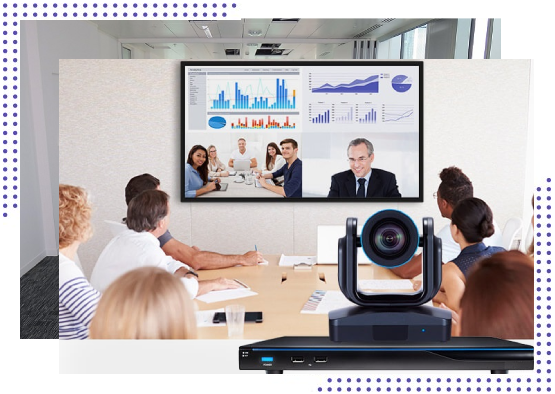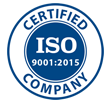
The core technology used in a videotelephony system is digital compression of audio and video streams in real time. The hardware or software that performs compression is called a codec (coder/decoder). Compression rates of up to 1:500 can be achieved. The resulting digital stream of 1s and 0s is subdivided into labeled packets, which are then transmitted through a digital network of some kind (usually ISDN or IP).
The other components required for a videoconferencing system include
- Video input: (PTZ / 360° / Fisheye) video camera, or webcam
- Video output: computer monitor, television, or projector
- Audio input: microphones, CD/DVD player, cassette player, or any other source of PreAmp audio outlet.
- Audio output: usually loudspeakers associated with the display device or telephone
- Data transfer: analog or digital telephone network, LAN, or Internet
- Computer: a data processing unit that ties together the other components, does the compressing and decompressing, and initiates and maintains the data linkage via the network.
There are basically two kinds of videoconferencing and videophone systems
Dedicated systems have all required components packaged into a single piece of equipment, usually a console with a high-quality remote-controlled video camera. These cameras can be controlled at a distance to pan left and right, tilt up and down, and zoom. They became known as PTZ cameras. The console contains all electrical interfaces, the control computer, and the software or hardware-based codec. Omnidirectional microphones are connected to the console, as well as a TV monitor with loudspeakers and/or a video projector. There are several types of dedicated videoconferencing devices
Large group videoconferencing are built-in, large, expensive devices used for large rooms such as conference rooms and auditoriums. Small group videoconferencing is either non-portable or portable, smaller, less expensive devices used for small meeting rooms. Individual videoconferencing are usually portable devices, meant for single users, and have fixed cameras, microphones, and loudspeakers integrated into the console.
Desktop systems are add-ons (hardware boards or software codec) to normal PCs and laptops, transforming them into videoconferencing devices. A range of different cameras and microphones can be used with the codec, which contains the necessary codec and transmission interfaces. Most of the desktops systems work with the H.323 standard. WebRTC Platforms are video conferencing solutions that are not resident by using a software application but is available through the standard web browser. Solutions such as Adobe Connect, and Cisco WebEX can be accessed by going to a URL sent by the meeting organizer and various degrees of security can be attached to the virtual "room". Often the user will be required to download a piece of software, called an "Add In" to enable the browser to access the local camera, microphone and establish a connection to the meeting. WebRTC technology doesn't require any software or Add On installation, instead a WebRTC compliant internet browser itself acts as a client to facilitate 1-to-1 and 1-to-many videoconferencing calls. Several enhanced flavours of WebRTC technology are being provided by Third Party vendors.
Video Conferencing Modes
Videoconferencing systems use two methods to determine which video feed or feeds to display. Continuous Presence simply displays all participants at the same time, usually with the exception that the viewer either does not see their own feed or sees their own feed in miniature. Voice-Activated Switch selectively chooses a feed to display at each endpoint, with the goal of showing the person who is currently speaking. This is done by choosing the feed (other than the viewer) which has the loudest audio input (perhaps with some filtering to avoid switching for very short-lived volume spikes). Often if no remote parties are currently speaking, the feed with the last speaker remains on the screen. Echo cancellation Acoustic echo cancellation (AEC) is a processing algorithm that uses the knowledge of audio output to monitor audio input and filter from it noises that echo back after some time delay. If unattended, these echoes can be re-amplified several times, leading to problems including
The remote party hearing their own voice coming back at them (usually significantly delayed)
- Strong reverberation, which makes the voice channel useless
- Howling created by feedback
- Echo cancellation is a processor-intensive task that usually works over a narrow range of sound delays.

Bandwidth requirements
Videophones have historically employed a variety of transmission and reception bandwidths, which can be understood as data transmission speeds. The lower the transmission/reception bandwidth, the lower the data transfer rate, resulting in a progressively limited and poorer image quality (i.e. lower resolution and/or frame rate). Data transfer rates and live video image quality are related but are also subject to other factors such as data compression techniques. Some early videophones employed very low data transmission rates with a resulting poor video quality. Broadband bandwidth is often called "high-speed", because it usually has a high rate of data transmission. In general, any connection of 256 kbit/s (0.256 Mbit/s) or greater is more concisely considered broadband Internet. The International Telecommunication Union Telecommunication Standardization Sector (ITU-T) recommendation I.113 has defined broadband as a transmission capacity at 1.5 to 2 Mbit/s. The Federal Communications Commission (United States) definition of broadband is 25 Mbit/s. Currently, adequate video for some purposes becomes possible at data rates lower than the ITU-T broadband definition, with rates of 768 kbit/s and 384 kbit/s used for some video conferencing applications, and rates as low as 100 kbit/s used for videophones using H.264/MPEG-4 AVC compression protocols. The newer MPEG-4 video and audio compression format can deliver high-quality video at 2 Mbit/s, which is at the low end of cable modem and ADSL broadband performance.





